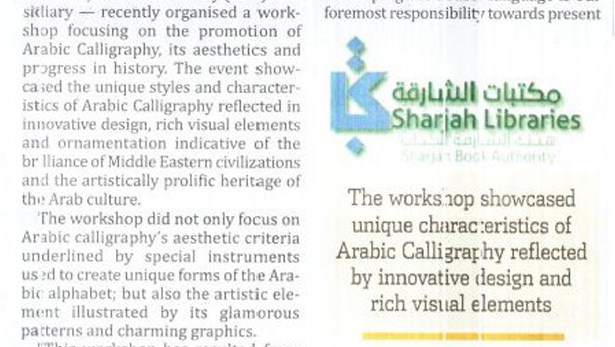Sharjah Public Library Celebrates Arabic Calligraphy
 Date: - Sep 28, 2016
Date: - Sep 28, 2016 
Arabic Calligraphy reflected in innovative design, rich visual elements and ornamentation indicative of the br Mance of Middle Eastern civilizations and the artistically prolific heritage of the Arab culture.
The workshop did not only focus on Arabic calligraphy’s aesthetic criteria underlined by special instruments used to create unique forms of the Arabic alphabet; but also the artistic element illustrated by its glamorous patterns and charming graphics. “This workshop has resulted from our keenness to promote crucial elements of the Arabic identity, and retain its constituents. The uniqueness of Arabic calligraphy is manifested by its architecture and design. The blending of letters forms an entity of rare beauty; artistic expressions that point ou the alphabet’s richness. Arabic calis of the most important historical bridges in the transference of ow knowledge and culture. It is also ore dited as being a common art frame representing cultural identities across Arab nations,” said Sara Al Marzouqi, Sharjah Public Library Manager. “Through this workshop, we have endeavoured to empower the Arabic language by encouraging innovation and creativity, which will serve to enhance the fundamentals of cultural sponsorship, and through the inclusion of reading, the identi ricati an of the rich aesthetics of th a language. The UAE gives the Arabic language special importance because it is the main component of our national id entity, and the primary link with Islamic culture. Nurturing and developing the /,rabic language is our foremost responsibility towards present and future she added. The workshop featured storytelling sessions on a group of calligraphers throughout history, enunciating how historical time-sf ifts witnessed the development of some calligraphy art styles, while the decay and degeneration of others; exploring its historical discourse among peoples and civilizations. This activity provided a valuable account on the development of Arabic calligraphy in its different stages. Participants at the workshop experienced calligraphy writing with different instruments such as dried reed and bamboo pens, regular ink pens and special ink pens for glassy paper, in addition to writing their in tials and names using glitter and gold calligraphy ink. Image(s) text: ‘Sharjah Libraries The works lop showcased unique of Arabic Calligraphy reflected by innovative design and rich visual elements



